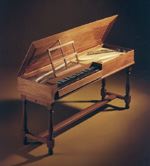|
Question: I don't know the difference between a harpsichord, virginal, spinet and clavichord. HELP!
Answer: Relax! Virginals and spinets are harpsichords. Clavichords are not. Clavichords do not pluck. Virginals are plucked like harpsichords, but are strung laterally. Spinets are also plucked and have a sort of triangular shape. Both have one set of strings, 1 X 8'. A clavichord is a sensitive, soft toned keyboard instrument. When you press a clavichord key, a metal tangent hits the string from below, creating sound. Variable pressure causes vibrato. Simple! This Flemish double manual harpsichord after Ruckers has a disposition of 2 X 8' X 4' and buff. The Flemish style called for a painted case (sometimes done in faux marble) and an occasional latin motto inscribed on the lid. A repeating graphic motif around the keyboard was created with the use of specially printed paper.
Question: So how does a harpsichord work? ...and am I spelling it correctly?!
Answer: On the spelling you get an A+! When you sit down at a harpsichord and press a key, the key (which extends far beyond your visual range) pushes the jack upwards, causing the plectrum (quill) to pluck a string. Nowadays, most people use delrin as their quill material, rather than crow. When you release the key, the tongue allows the plectrum to rotate past the string and a damper stops the string from vibrating. That is all there is to it! Bravo! You think you're finished now, but you're not...
Question: What do you mean by disposition?
Answer: Disposition describes your hardware layout.
Question:So what is an 8 foot stop?
Answer: It refers to the pitch of an 8 foot long organ pipe, or "normal pitch." A 4 foot stop sounds an octave higher. The "stop" lever turns the register on and off.
Question: So how do I know if it is a quality instrument?
Answer: If you are ready to make an investment of this size, you want to know that it will last for generations. It either lasts for a day or two, or it lasts way beyond your lifetime. And do not trust everything you hear on the Internet. You have to talk to a player, and find out if the maker's instrument holds up to practicing and concert conditions. And don't ever underestimate yourself. You need the same kind of instrument because if it doesn't function, you can't play it.
Question: How much maintenance is required?
Answer: Harpsichords need to be played regularly!!
Regarding climate... everybody wants to know about climate. I want to discuss consistency in humidity levels. If you live, say, in Arizona, I would assume the humidity level indoors (which is where I would assume your harpsichord lives) is naturally dry, and we would want to keep it that way, so if you have a sudden rainstorm and the humidity rises to 50%, you have to do a tuning. If you live in New York City, the indoor humidity with the steam heat in the winter will give you a low indoor humidity level, and you will need to have a humidifier, to keep yourself at about 45%. Just listen, keep it steady, and don't shock it. Learn how to tune (or marry a tuner -- it has happened).
|
|


